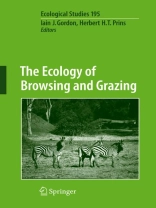Extensive grazing and browsing by domestic and wild herbivores shape the vegetation composition, structure and dynamics of many terrestrial ecosystems. This volume investigates how large herbivores not only influence the structure and distribution of the vegetation, but also affect nutrient flows and the responses of associated fauna. The mechanisms and processes underlying the herbivores’ behaviour, distribution, movement and direct impact on the vegetation, and the dynamics of nutrients, plant species, and vegetation composition in terrestrial ecosystems are discussed in detail. It is shown that an understanding of plant/animal interactions can provide practical advice on the management of large herbivores to integrate production and conservation in terrestrial systems, particularly in the face of environmental and climate change.
Tabella dei contenuti
Introduction: Grazers and Browsers in a Changing World.- An Evolutionary History of Browsing and Grazing Ungulates.- The Morphophysiological Adaptations of Browsing and Grazing Mammals.- Nutritional Ecology of Grazing and Browsing Ruminants.- The Comparative Feeding Bahaviour of Large Browsing and Grazing Herbivores.- The Comparative Population Dynamics of Browsing and Grazing Ungulates.- Species Diversity of Browsing and Grazing Ungulates: Consequences for the Structure and Abundance of Secondary Production.- Impacts of Grazing and Browsing by Large Herbivores on Soils and Soil Biological Properties.- Plant Traits, Browsing and Gazing Herbivores, and Vegetation Dynamics.- The Impact of Browsing and Grazing Herbivores on Biodiversity.- Managing Large Herbivores in Theory and Practice: Is the Game the Same for Browsing and Grazing Species.- Grazers and Browsers in a Changing World: Conclusions.












